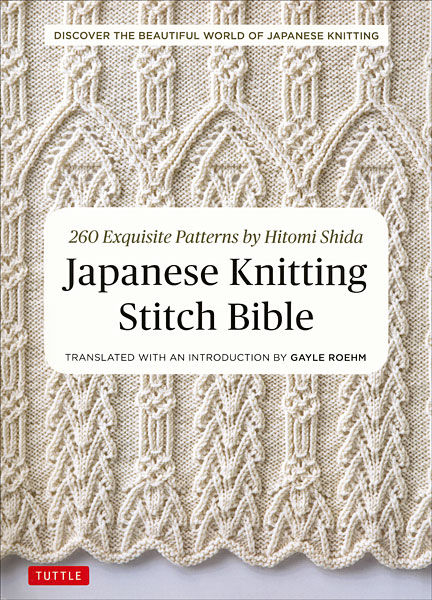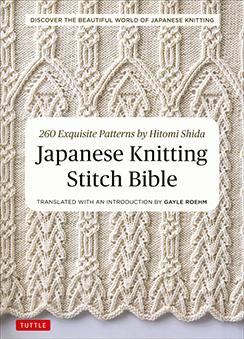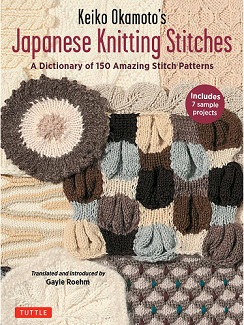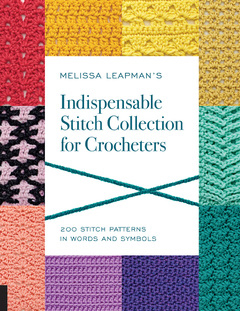Spectacular New Lace and Cable Knitting Patterns
I have a new knitting heroine. Her name is Hitomi Shida, and she is the author of a book filled with spectacular patterns for knitting the most amazing cable and lace designs imaginable. I can’t wait to tell you about this book!
While I have no idea how long Hitomi actually spent developing these designs, I can say this: It would have taken me just about my entire lifetime to work out this volume of incredibly complex, sophisticated patterns. Even if I had invested all that time, there is no guarantee I would have come up with designs that are this incredible.
The best part: The book also includes instructions for making finished projects that incorporate these lovely designs. So you basically get a knitting stitch dictionary and a knitting pattern book, all in one.
If you’re an intermediate or advanced knitter and you want to make jaw-dropping, impressive projects, the Japanese Knitting Stitch Bible is a book you simply need to have in your library. It’s an amazing value for the money you spend on it. The short version of my review: Definitely >buy this book — I think you’re going to love it!
What You Need to Know About This Knitting Stitch Dictionary:

Author: Hitomi Shida
Translator: Gayle Roehm
Publisher: Tuttle Publishing
ISBN 13: 978-4-8053-1453-1
Book Formats:
This book is available in the following format(s):
Number of Pages: 160
Topics Covered in This Book:
- How to read Japanese stitch pattern charts; symbol definitions
- How to interpret the charts when you’re knitting back and forth
- How to interpret the charts when you’re knitting in the round
- How to knit “knot” stitches
- Lace knitting patterns
- Overall knitting patterns
- Crossed stitch patterns
- Knit pattern panels
- Round knitted yoke patterns: Learn how to knit lovely, lacy round collars and yokes
- Knit edging patterns
- How to combine crocheted bobbles with lace knitting, cable knitting and crossed stitch patterns to make beautiful and fascinating textured textiles
- Bead embroidery on knitting (there are several stitch patterns that incorporate this technique, but bead embroidery is not a main focus of the book by any means).
- New popcorn knitting stitch patterns
- How to do a tubular cast on
Knitting Projects Included in This Book:
1. Mini Scarf With Frill
This luxurious scarf is included in the “Lacy Patterns” section of the book. The scarf incorporates two different stitch patterns from the book; one is a lacy cable motif and one is a frilly ruffled edging pattern.
2. Cable Knit Socks for Warm Feet
This project is included in the section called “Overall Patterns and Crossing Stitches”. These are classic socks that will never go out of style.
3. Hat With Crossed Stitches and Lace
This hat would be just a simple beanie shape if not for the intricate textured cable motifs incorporated into the design. This pattern is included in the “Pattern Panels” section of the book.
4. Cute Fingerless Mitts
These are some of the most sophisticated mitts I’ve ever seen. They look warm, comfortable and beautiful. The mitts are included in my favorite section of the book, the section that focuses on pattern arrangements.
5. Elegant Decorative Collar
If you have a garment that’s in need of dressing up, this feminine collar is an option worth considering. It would work for enhancing a variety of different wardrobe pieces, from a too-simple cardigan sweater to a wintery wedding dress.
There’s a whole section of the book devoted to collars and yokes; so if this is a project idea that appeals to you, you have a whole bunch of truly exciting options to consider.
Actually, when I’ve been looking at this section of the book, new ideas keep popping into my head for different and unrelated things to do with these designs. So far the ideas I want to try most: I’d like to make several peplum sweaters for my baby daughter incorporating these gorgeous ruffles into the design. Or maybe I’d use a thicker yarn to make her a snuggly, warm poncho similar to one of these.</P.
I think you’re likely to be inspired with abundant ideas of your own when you look at these gorgeous designs.
The Best Things About The Japanese Stitch Bible
The projects in the book are all interesting, beautiful, appealing and totally wearable.
The stitch patterns are all truly inspiring. There are no duds at all! Every single one of them is usable.
The photography in this book is excellent, and the styling is minimal but effective. The projects are laid flat on one-color, barely textured backgrounds. There’s nothing whatsoever to distract you from the projects and the stitches. You’ll easily be able to envision whether the projects are ones you’ll want to add to your wardrobe.
I’ve already raved about the quality of the design work you’ll find in this book, but it bears repeating. These stitch patterns are the stuff that haute couture is made of. If you’re inclined to invest some time plus a few high-quality skeins of yarn, this book will give you the instructions you need for making accessories that look like they’re fresh off the runways. You could take a small yarn investment and make it look like you spent a small fortune on each of your new accessories.
One of my favorite things about this book: There is an entire section devoted to “pattern arrangements”. In this section, the author takes some of the stitch patterns (which are complex and lovely to start with) and transforms them into different variations that are even more interesting. I found it fascinating to see how she varied each stitch pattern in this section to create a new look.
Both the original and the new interpretation are pictured together, side by side, with the corresponding charts arranged right below them. This allows you to study each variation to understand exactly what has changed. If you’re at all interested in / curious about knit design, this section of the book is going to be invaluable to you for understanding how to put together design elements to create interesting stitch patterns.
If you’d be interested in knitting coordinated collections of clothing or home décor items that look cohesive yet don’t come across as excessively matchy-matchy, I believe this section of the book is going to be tremendously valuable to you for that reason as well. And even if you don’t want to create collections, I think it could be interesting to use these variations together in the same garments or home décor items.
The Japanese Stitch Bible is an incredible value for the money you’ll spend on it. In my opinion, you’ll get much more than your money’s worth when you buy this book. Owning the book is like having a shortcut to 20 years’ worth of sophisticated knit design work. Seriously, if you like to knit pretty things, how could you pass that up?
Other Observations About This Book
There is a TON of fantastic information packed into this relatively compact 160-page volume. I’m convinced that the team that put the book’s layout together is comprised of graphic design geniuses. There’s NO wasted space in the book, yet it doesn’t seem overly cluttered or “busy”.
There are a couple of tradeoffs for having this unheard-of amount of information packed into such a relatively small number of pages. One of these tradeoffs: the symbols are presented in one compact 11-page guide. You’ll need to refer to each of these symbols for knitting multiple stitch patterns in the book. To avoid doing a lot of page flipping, I found it helpful to photocopy guide to the symbols. Before I thought of doing that, I was spending a lot of time flipping back and forth between that section and whichever pattern I was looking at or attempting to work on.
If you aren’t already accustomed to working with Japanese knitting patterns, expect to spend some time familiarizing yourself with them before you can successfully knit these patterns. There’s a learning curve that isn’t the fault of this book. The author and translator clearly communicate the concepts, but despite that, it could take you some time to master them. The finished projects in the book would all make excellent gifts; but if you want to make them as gift for loved ones, be sure to allow ample time for it. They won’t work as last-minute rush gifts unless you’re a knitting genius with major speed-knitting skills. It’s wise to allow ample time for the process of understanding and mastering the charts and then lovingly knitting each gift.
The other tradeoff: Most of these stitch patterns are presented using symbols only; written-out text instructions are not included unless the author and /or translator felt words were necessary to describe some aspect of the pattern. However, in the back of the book, there are multiple pages devoted to step-by-step photo tutorials with text. These tutorials will teach you how to do some of the knitting techniques that might be unfamiliar to you. So, you have the information you need to work these patterns if you’re willing to familiarize yourself with the symbols that comprise these charts.
My understanding is that this charting convention is standard in Japan. So if Japanese knitting patterns interest you, it seems to me that there’s a HUGE benefit in making the effort to understand this charting convention. It is my understanding that owning this book, which so clearly explains the Japanese way of charting knitted stitches, could possibly allow you to also understand and interpret other Japanese knitting pattern books — even ones that haven’t been translated into English. I don’t happen to own any other Japanese knitting pattern books at the moment to test this out and see if I could actually make sense of them using the stitch guide and tutorials presented in this book. I welcome reader comments from anyone who has made the attempt to do so; I’d love to know what your experiences have been, and I am sure our readers will be interested in any relevant insights as well.
Conclusion
I’m delighted to recommend this book to other knitting enthusiasts, particularly intermediate and advanced knitters who are looking for unique, interesting and out-of-this-world-gorgeous new stitches and projects to work on.
This is NOT a beginner’s knitting book — but if you’re a beginner, Japanese Knitting stitch Bible could possibly be a good buy anyway if you want some motivation and inspiration for taking your knitting skills to the next level. It depends on your goals for your knitting.
If your goal is simply to kick back and relax with your knitting, this might not be the best book for you — because most knitters are not likely to find these projects to be particularly easy or relaxing. But if your goal is to knit the most SPECTACULAR, the most AMAZING and the most IMPRESSIVE projects possible, the Japanese Knitting Stitch Bible is exactly the book you want to reach for. It’s also the book you’ll want to have handy if your wardrobe could use some rich-looking new accessories — even if you don’t care to spend like the Trumps on your new pieces.

- With a cover price of only $16.95, this book is affordable for knitters of just about any income bracket.
Where to Buy This Book:
- You can support independent book shops by shopping for this book at Bookshop.org.
- Click or tap here to shop for this book at Amazon.
More From Hitomi Shida:
When I first got my hands on The Japanese Knitting Stitch Bible, I thought to myself, “This woman in a genius! I gotta get my hands on every book she has ever written!” If you want more, too, there’s another book you should know about: It’s 250 Japanese Knitting Stitches the Original Pattern Bible by Hitomi Shida. This is another amazing book filled with spectacularly gorgeous knitting stitches and projects. The same team from Tuttle Publishing put together both books. If you like The Japanese Knitting Stitch Bible, you’re most likely also going to enjoy 250 Japanese Knitting Stitches, too.
More Stitch Dictionaries, Knitting Pattern Books and Related Resources

- Keiko Okamoto’s Japanese Knitting Stitches: A Stitch Dictionary With 150 Amazing Patterns — This lovely stitch dictionary includes cable knit stitches, lace stitches, smocking stitches, lace motif patterns, colorwork patterns and more.
- 6,000+ Pullover Possibilities: If you want to learn how to design your own pullover knit sweaters, this new knitting book of Melissa Leapman’s offers you a fantastic shortcut to creating just about any type of design you could wish for. I haven’t yet tried incorporating the stitch patterns from the Japanese Knitting Stitch Bible into these patterns to see how well that would work, but it is on my to-do list to try it. It looks to me like these two books would make good companions for each other.
- The Alterknit Stitch Dictionary — Stranded colorwork knitting patterns are the main focus of this stitch dictionary; that’s a topic that the Japanese Knitting Stitch Bible doesn’t cover, so buying the two books together would give you a broader variety of options for knitting stitch patterns and projects.
- Melissa Leapman’s Indispensible Stitch Collection for Crocheters — This is currently my favorite crochet stitch dictionary. This book gives you instructions for crocheting cables, colorwork patterns, edgings, shell stitches, lace patterns and more.
- Dimensional Tuck Knitting — If you enjoy textured knitting, this innovative book features an intriguing technique you’ll want to know about

Find More Excellent Japanese Knitting Books HERE.
Knitting Tools and Supplies
More Knitting Knowledge:
More Craft Pages You Might Enjoy:
Find More Craft Project Ideas HERE!
Posted By: Amy Solovay
This page was last updated on 8-4-2023.